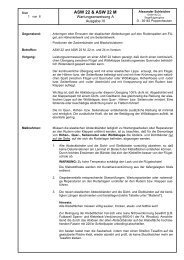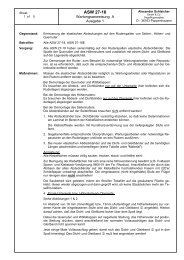ASW 28 - Alexander Schleicher
ASW 28 - Alexander Schleicher
ASW 28 - Alexander Schleicher
Create successful ePaper yourself
Turn your PDF publications into a flip-book with our unique Google optimized e-Paper software.
<strong>ASW</strong> <strong>28</strong><br />
The <strong>ASW</strong> <strong>28</strong> is <strong>Schleicher</strong>’s new high performance glider for the FAI-Standard Class incorporating the very<br />
latest technology, both in wing section and boundary layer control, and using the most advanced carbon, aramide<br />
and polyethylene fibres in its construction. Moreover, this glider is type-certified for cloud flying and semiaerobatics.<br />
Current modern design theory leads us to examine the climb portion of the performance as much as the run<br />
part. This leads to a sailplane, which will climb a little better and run a little better than current design.<br />
The <strong>ASW</strong> <strong>28</strong> will be a little lighter, more crashworthy and safer. Taken all together, this is a large step forward.<br />
A more detailed view of the <strong>ASW</strong> <strong>28</strong> shows the roomy safety cockpit offers all modern comforts and ease of<br />
operation, even for tall pilots. The cockpit, designed according to latest research results in the field of safety<br />
and accident protection, includes a glider rescue system as an option for the near future. The rubber-shockmounted,<br />
retractable landing gear with „crush zone“ in the steel struts for overload and hydraulic disc brake,<br />
the adjustable backrest, the upwards-hinging instrument panel and the speed trim, are only some of the many<br />
available conveniences.<br />
The high performance wing airfoil with boundary layer control by means of turbulator holes or suitable trip devices<br />
like ZZ-tape, combined with an outstanding construction quality, imparts to the <strong>ASW</strong> <strong>28</strong> flight performances<br />
that are superior to those of the former „Racing Class“ gliders. Due to the high construction quality of<br />
the wing and of the control surface gap sealing it has been possible to build a production wing with laminar airflow<br />
of 85% along the profile underside. The sophisticated control linkage system gives high manoeuvrability<br />
and docile flight characteristics, even in landing approach.<br />
The low-drag airfoils of the T-tail (elevator with stabiliser and fin and rudder) were developed by the Delft University<br />
of Technology. Elevator and rudder are new-technology sandwiches of Aramide fibre / plastics with a<br />
hard foam core. All control surface hinges of the wing and of the horizontal tail unit use needle bearings or<br />
low-maintenance plastic bearings. The actuating levers and bellcranks are fitted with ball bearings or precise<br />
"uniball"-joints. While the desirable feedback from the air loads at the control surfaces can still just be felt at<br />
the stick, the hand forces for the pilot are comfortable, - a pre-condition for non-fatiguing flying.<br />
Despite the low entry numbers due to late introduction the new <strong>ASW</strong>-<strong>28</strong> is performing quite well in soaring<br />
contests world wide. For results see the AS web site www.alexander-schleicher.de
<strong>ASW</strong> <strong>28</strong><br />
A new FAI Standard Class Glider<br />
The <strong>ASW</strong> <strong>28</strong> is a new high performance glider for the FAI-<br />
Standard-Class, incorporating the latest technology both in<br />
aerodynamic design and most advanced fibre hybrid technology,<br />
a clever mix of carbon, aramide (Kevlar), polyethylene<br />
and glass fibres.<br />
Successor of the <strong>ASW</strong> 19 and the <strong>ASW</strong> 24<br />
There has been customer pressure for <strong>Schleicher</strong> to build a<br />
new Standard Class glider, which would exceed current gliders<br />
in performance by combining the proven high-speed performance<br />
with the outstanding climbing qualities, and handling as<br />
has been achieved with the <strong>ASW</strong> 27 in turbulent thermals.<br />
We took advantage of the well-proven qualities of the upper<br />
side airfoil of the <strong>ASW</strong> sailplanes line in Open- and Racing<br />
Class, which have demonstrated continuous improvement in<br />
providing higher effective lift in circling flight - also in turbulent<br />
thermals. The larger camber similar to the <strong>ASW</strong> 27 airfoil is<br />
distinctly visible at the <strong>ASW</strong> <strong>28</strong> wing and illustrates this characteristic.<br />
Due to high construction quality of the wing and control<br />
surface gap sealing, it has been possible to build a production<br />
wing with laminar airflow of 85% along the profile underside.<br />
In addition aerodynamic research was intensively continued.<br />
Thus <strong>Schleicher</strong> accumulated important results with the design<br />
of winglets that are a standard feature with the <strong>ASW</strong> <strong>28</strong>. For<br />
the wing tip the airfoil was modified in view of lower Reynoldsnumbers<br />
and for the wing-to-fuselage transition the airfoil was<br />
upgraded.<br />
Uncompromising<br />
The <strong>ASW</strong> <strong>28</strong> has been designed uncompromisingly for highest<br />
flight performance and characteristics in the 15 m span configuration<br />
as we deliberately chose not to give any compromise<br />
to a possible span increase or engine retrofitting option.<br />
Thus, owing to the systematic specification as a high performance<br />
glider with 15 m span, the wing has a high aspect ratio.<br />
Also an optimum wing plan form including the special requirements<br />
for a 0,5 meter high winglet could be verified.<br />
Variable<br />
The <strong>ASW</strong> <strong>28</strong>-18 is a new variant with two pairs of outboard<br />
wings so that it can be flown with 15 m and 18 m span. The<br />
2<br />
span extension to 18 m, however, is only possible when the<br />
inner wing spar is reinforced and the outboard wing area is<br />
modified. An intersection at 5,25 m semi span allows designing<br />
a minimum drag outboard wing. As another Variant called<br />
<strong>ASW</strong> <strong>28</strong>-18 E this sailplane can also be equipped with a sustainer<br />
power-plant, see a separate prospectus.<br />
New Fibre Composite Technology<br />
In the field of fibre composite materials, great advances have<br />
taken place. This means that very strong, yet very lightweight<br />
structures can be made with high energy absorption. By using<br />
„hybrid (mixed) laminates“ of these new synthetic fibres together<br />
with carbon fibres it is possible to further improve the<br />
crashworthiness of the <strong>ASW</strong> <strong>28</strong> cockpit but reduce the structural<br />
weight.<br />
Optional Glider Rescue System<br />
As an option the <strong>ASW</strong> <strong>28</strong> can be fitted with a ballistic parachute<br />
system. Streifeneder and the Russian firm MVEN are<br />
working with a mortar, which pushes the big parachute free<br />
from the sailplane. The possible removal of the conventional<br />
parachute from the cockpit means greater comfort for the taller<br />
pilot with the cockpit tightly tailored around him. An upholstered<br />
bucket seat and back rest with side support and an integrated<br />
head rest (similar to racing cars) will further improve<br />
safety and comfort.<br />
The Polar<br />
Given a wing area of 10,5 m² and a max. all-up weight of<br />
525 kg, water-ballast included, it is possible to vary the wing<br />
loading in the range between about 30 kg/m² (75 kg cockpit<br />
load) and 50 kg/m² (with full water ballast on board).<br />
To calculate theoretically the future performance of this new<br />
glider, the known, proven figures of the <strong>ASW</strong> 24 performance<br />
were used as a basis. By using computers, figures resulting<br />
from tests of individual components were exchanged with<br />
those of the <strong>ASW</strong> <strong>28</strong>. The results were fantastic. And as all<br />
wing airfoils have been designed by the same computer programs<br />
and measured in the same wind tunnel, these results<br />
are quite accurate.
Flying Qualities and Comfort<br />
<strong>ASW</strong> <strong>28</strong><br />
Fruitful co-operation with the leading low-speed aerodynamicists and own structural research allowed to design a new FAI-Standard-<br />
Class sailplane, which exceeds the performance level of the older “Racing Class” sailplanes like the famous <strong>ASW</strong> 20.<br />
Not only do excellent flying qualities characterize the <strong>ASW</strong> <strong>28</strong>, but also the serial equipment is complete.<br />
In our eyes this is necessary in order to provide both, safety and comfort for the performance-minded pilot.<br />
Standard Features<br />
- Sprung landing gear with large 5" wheel and 10 cm normal stroke, for overload using crush zone of struts 14 cm<br />
- Hydraulic disc brake<br />
- Tail wheel with fender<br />
- Instrument panel hinging upwards with the canopy<br />
- Nose and C.G. tow release coupling<br />
- Adjustable back rest with integrated head rest<br />
- Safety harness with quick-release centre lock<br />
- Battery storage space in the baggage compartment and in the fin<br />
- 3-way-nozzle (multi-probe) in the fin.<br />
- Directional air vent additionally to front canopy de-mist<br />
DESIGN SPECIFICATION and TECHNICAL DATA<br />
Glider, higher mid wing configuration with T-tail. Automatic connections for all controls (aileron, airbrakes,<br />
and elevator) and water ballast actuation.<br />
FUSELAGE Monocoque fuselage of fibre hybrid composite structure (CRP, Aramide, Polyethylene and GRP) with<br />
roomy safety cockpit. In flight adjustable rudder pedals. TOST C.G. “COMBY” tow release coupling,<br />
covered in flight by the landing gear doors, and TOST aero tow release coupling in the fuselage nose.<br />
Rubber-shock mounted, retractable landing gear, using a large 5.00-5 wheel, installed in a box that is<br />
sealed and airtight from the fuselage interior. Drag strut with designed weak link in case of overload.<br />
Hydraulic disc brake that is connected to the airbrake lever. Pneumatic tail wheel 210 x 65. Optimum<br />
cockpit ventilation through intake in the fuselage nose with continuously adjustable outlets, one on the<br />
front canopy frame and the other through a directionally adjustable air nozzle on the right cockpit wall.<br />
CANOPY The full-vision, gas-spring assisted canopy (with sliding window on the left side) is hinged at the front.<br />
Tongue and groove type sealing for the canopy frame and a specially shaped rear frame section for<br />
the purpose of a safe emergency jettison.<br />
INSTRUMENT PANEL The instrument panel is made to hinge upwards with the canopy; even when the canopy is open, the<br />
instruments are still covered. When the canopy emergency jettison system is operated, the canopy together<br />
with the instrument panel coaming can be removed and the instruments are easily accessible.<br />
WING Cantilever, two-part quadruple-tapered wing plan form with latest laminar airfoil; when flown high<br />
speed the laminar airflow at the wing underside goes back to the aileron gaps. Upon specific directions<br />
by SCHLEICHER, the airfoil was developed well aimed at the <strong>ASW</strong> <strong>28</strong> design at the faculty of<br />
Aerospace Engineering of the TU Delft. Tolerance to small-scale micro-turbulence was regarded.<br />
Plan form and airfoil of the outer wing have been modified for detachable winglets using the latest airfoil<br />
design. The wing surface is a sandwich of carbon fibre / plastics with a hard foam core; wing spars<br />
with carbon flanges. Double-panelled airbrakes (of metal and CFRP) on the wing upper surface, in<br />
sealed compartments with spring cover plates. Push rods sealed by bellows. The wing assembly is<br />
straightforward with a conventional tongue and fork spar extension secured with cylindrical main pins.<br />
Extremely lightweight wing. Control surface gaps on the wing upper and under side sealed by plastic<br />
tape. Turbulators on the under side and in front of the ailerons.<br />
WATER BALLAST Water ballast in the wing leading edge is filled into so called „wet surface tanks“, separated in two<br />
compartments per wing for the purpose of facilitating take offs with partial water ballast. The mechanic<br />
valve actuators are connected automatically when rigging the sailplane. Owing to a special design of<br />
the spar and of the leading edge web, we achieved a small but favourable C.G. shift due to water load<br />
(therefore, a water tank in the fin is hardly necessary). However for fine tuning C.G. a fin water ballast<br />
tank is available as an option as well as for compensating different cockpit loads. To avoid water<br />
damage to the structure, extra inner linings of the tanks are installed as well as ventilation to the winglet<br />
area. Filling is done through two faired drain outlets on the wing underside left and right of the fuselage.<br />
Ballast capacity is approx. 2 x 100 kg.<br />
TAILPLANE T-tail (elevator with stabiliser) with low-drag airfoil, developed by the TU Delft. Control surface gaps on<br />
both sides sealed with plastic tape; and turbulators on both sides in front of the control surface hinge<br />
line. Stabiliser in CRP-sandwich-construction. Vertical fin in GRP-Aramide-construction because of<br />
the VHF-antenna radiation. Elevator and rudder are new-technology sandwiches of Aramide fibre /<br />
plastics with a hard foam core; ailerons are of Aramide monocoque construction that gives extremely<br />
light and stiff control surfaces.<br />
CONTROL CIRCUITS AND<br />
3
<strong>ASW</strong> <strong>28</strong><br />
FITTINGS Aileron, elevator and airbrakes are actuated by push rods running in anti-noise ball bearings, and use<br />
automatic connections at the assembly joints. The rudder is actuated by stainless steel cables, which<br />
run in Polyamide tubing. Infinitely variable trim, lockable by a stick-mounted key. All control surface<br />
hinges of the wing and of the horizontal tail unit use needle bearings or low-maintenance plastic bearings.<br />
The actuating levers and bellcranks are fitted with ball bearings and precise „uniball“-joints. This<br />
provides the lowest possible actuating forces for the pilot and guarantees comfortable, non-fatiguing<br />
flying. The fittings are welded steel and milled or turned aluminium alloy respectively.<br />
BOARD EQUIPMENT AND<br />
ACCESSORIES Static pressure vents (for the A.S.I.) in the fuselage tail boom left and right. Pitot, static pressure and<br />
TE-compensation through 3-way-nozzle (multi-probe) in the fin. VHF antenna in the fin.<br />
OPTIONAL<br />
RESCUE SYSTEM For the <strong>ASW</strong> <strong>28</strong> the installation of a „Sailplane Rescue System“ is planned. A large parachute is<br />
pulled out by a rocket or pushed out by a mortar, which will be actuated either by the pilot or an automatic<br />
system after a major part breaks off from the sailplane. The whole sailplane including pilot is<br />
brought down slowly in a nose down attitude and the fuselage nose absorbs the impact energy, so<br />
that the pilot is not hurt. The rescue system saves time and altitude compared to a conventional backpack<br />
parachute and will allow save rescue from lower altitudes. A rescue system weighs some more<br />
than a backpack parachute. The latter however is no longer necessary, so that a more comfortable<br />
and crashworthy backrest can be installed. Also taller pilots can fit into the cockpit.<br />
TECHNICAL DATA Span incl. Winglets 15 m 49,21 ft Mass of one wing 62 kg 136 lb<br />
Wing area 10,5 m² 113,02 sqft Max. wing loading 50 kg/m² 10,24 lb/sqft<br />
Wing aspect ratio 21,43 Min. wing loading ≈30 kg/m² 6,14 lb/sqft<br />
Fuselage length 6,585 m 21,6 ft Water ballast, max. 200 l 52,8 US gal<br />
Cockpit height 0,80 m 2,62 ft Useful load, max. 130 kg <strong>28</strong>6,6 lb<br />
Cockpit width 0,64 m 2,1 ft Useful load in the pilot seat, max. 115 kg 253,5 lb<br />
Height at tailplane 1,3 m 4,26 ft Max. speed 270 km/h 145 kts<br />
Winglet height 0,5 m 1,64 ft Manoeuvring speed 200 km/h 108 kts<br />
Wing airfoil: centre part DU 99-147<br />
Aileron section DU 99-147 M1 For 325 kg (716 lb) flight mass:<br />
Outer wing DU 99-147 M2<br />
Winglet airfoil DU 99-125 Min. speed 70 km/h 38 kts<br />
Empty mass with min. equipment 240 kg 529 lb Min. sink 0,55 m/s 108,3 ft/min<br />
Max. take-off mass 525 kg 1157,4 lb Best glide ratio (@ 92 km/h) 45<br />
<strong>Alexander</strong> <strong>Schleicher</strong> GmbH & Co. Segelflugzeugbau<br />
D-36163 Poppenhausen (Wasserkuppe) <strong>Alexander</strong>-<strong>Schleicher</strong>-Straße 1<br />
D-36161 Poppenhausen (Wasserkuppe) P.O. Box 60<br />
Tel. ++49 (0) 66 58 / 89-0<br />
Fax ++49 (0) 66 58 / 89 40<br />
e-mail: info@alexander-schleicher.de<br />
homepage: www.alexander-schleicher.de<br />
Design and construction subject to change without prior notice. Issue: July 2003


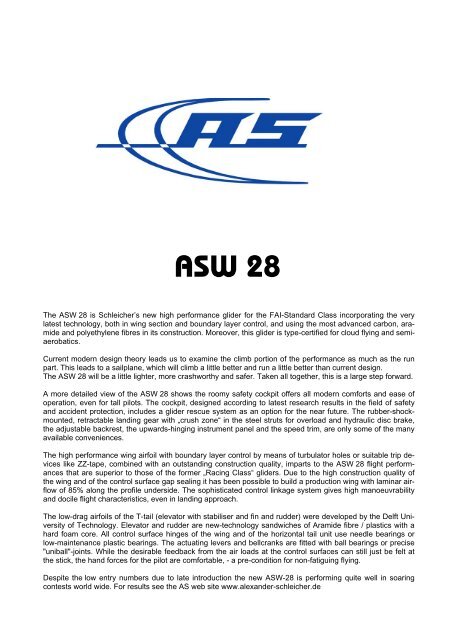
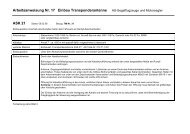


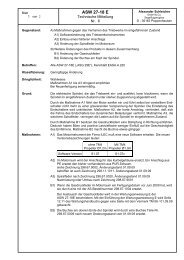
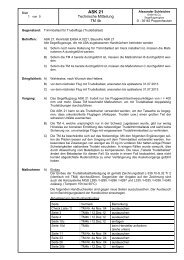
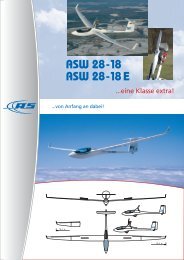



![AD 2012-0246 [PAD 12-122 task 2012.251] Schleicher-Ka6 K7 K8 ...](https://img.yumpu.com/8336662/1/184x260/ad-2012-0246-pad-12-122-task-2012251-schleicher-ka6-k7-k8-.jpg?quality=85)


